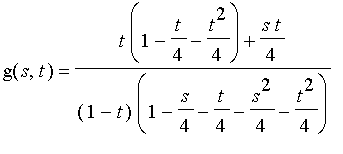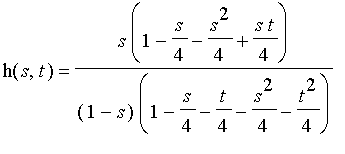recherch_xvi.mws
Recherches sur
l'intégration des équations différentelles aux
différences finies, et sur leur usage dans la théorie des
hasards.
P.S. Laplace
PROBLEM
XVI.
I
suppose the tickets
A1, A2, B1 and B2
, contained in an urn, and that two players A
and
B play on this condition that A choosing the tickets
A1 and
A2 , and B the
two others,
if one draws each time one alone of these tickets at random, the one of
the
two players will win, who first will have attained the number i, the
tickets
A1
and
B1
counting
for 1, and the tickets A2
and B2
counting for 2. This put, if there lacks n
units
to the player A and
 units to player B,
one asks the respective probabilities
of the two players A and B to win.
units to player B,
one asks the respective probabilities
of the two players A and B to win.
Laplace
expresses the solution
as a recurrence relation which is a function of
n and
x .
Unfortunately he
merely sketches the path towards a solution. Laplace does not
completely
solve the problem nor does he offer a numerical example. We'll
construct
a recurrence relation based on
n and
 instead.
instead.
Let's
let
 be the number of
points lacking to player
B. Let
be the number of
points lacking to player
B. Let
 be the probability
that player B wins.
Since the player may reach this state from the previous by drawing any
one
of the four tickets with equal probability, we must have
be the probability
that player B wins.
Since the player may reach this state from the previous by drawing any
one
of the four tickets with equal probability, we must have

However,
Laplace notes that
if player A lacks but 1 point, then the tickets A2 and B2 should be
removed
from play so that
 . Laplace does not say so, but
this condition
must be symmetric. Therefore,
. Laplace does not say so, but
this condition
must be symmetric. Therefore,
 as well. Of course, the boundary
conditions
require that
as well. Of course, the boundary
conditions
require that
 for
for
 and
and
 for
for
 .
.
We may therefore implement this recurrence relation as
>
B:=proc(n,m)
> if n=0
then 0 elif m=0 then 1 elif (n=1 or m=1) then (B(n-1,m)+B(n,m-1))/2
else
(B(n,m-1)+B(n,m-2)+B(n-1,m)+B(n-2,m))/4 fi; end:
In
the same manner, let
 be the
probability of player A winning.
The recurrence relation is analogous with only the boundary conditions
being
altered and we may implement it easily as
be the
probability of player A winning.
The recurrence relation is analogous with only the boundary conditions
being
altered and we may implement it easily as
>
A:=proc(n,m)
> if n=0
then 1 elif m=0 then 0 elif (n=1 or m=1) then (A(n,m-1)+A(n-1,m))/2
else
(A(n,m-1)+A(n,m-2)+A(n-1,m)+A(n-2,m))/4 fi; end:
Clearly,
 for all values of
n and
m .
for all values of
n and
m .
Moreover,
by symmetry, we
must have
 for
all
for
all
 .
.
>
B(3,3);

>
B(3,2);

>
A(3,2);

>
The
solution in
TAP . This problem is repeated in TAP
where
Laplace changes the rules slightly in that he allows a player who lacks
one
point to win by drawing either the ball labeled with 1 or with 2. He
solves
this problem in terms of the number of points each player is lacking
using
generating functions. As before, let players A and B lack
m and
n points
respectively.
The
generating function
of A winning is
 and
that of B winning is the same with
s
and
t
interchanged, namely
and
that of B winning is the same with
s
and
t
interchanged, namely

>
g:=(t*(1-t/4-t^2/4)+s*t/4)/(1-t)/(1-s/4-t/4-s^2/4-t^2/4):
>
h:=(s*(1-s/4-s^2/4)+s*t/4)/(1-s)/(1-s/4-t/4-s^2/4-t^2/4):
Now,
the probability that
player A wins given that he lacks
m and his
opponent
lacks n is
the coefficient of the term
 in the expansion of
the generating function
in the expansion of
the generating function
 . For
example, if player A lacks 3 and
player B lacks 2, player A will win with probability
. For
example, if player A lacks 3 and
player B lacks 2, player A will win with probability
 .
.
>
mtaylor(g,{s=0,t=0},6);

In
the same manner, the
probability that player B wins given that player A lacks
m and his
opponent
lacks n is
the coefficient of the term
 in the expansion of
the generating function
in the expansion of
the generating function
 . Thus,
if again player A lacks 3 and player
B lacks 2, player B will win with probability
. Thus,
if again player A lacks 3 and player
B lacks 2, player B will win with probability
 .
.
>
mtaylor(h,{s=0,t=0},6);

>
We
note that the solutions
do differ but only slightly from one another.
![]() for all values of
n and
m .
for all values of
n and
m .
![]() for
all
for
all
![]() .
.